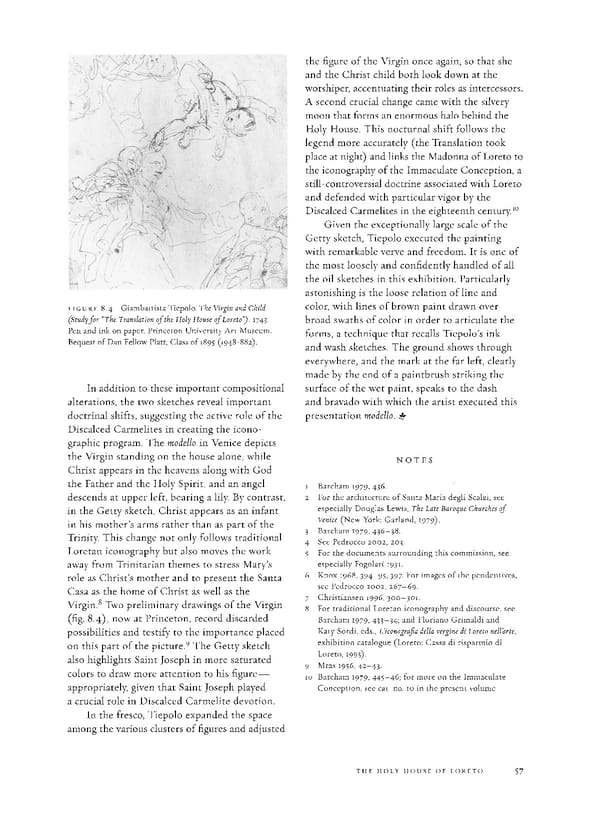the figure of the Virgin once again, so that she and the Christ child both look down at the worshiper, accentuating their roles as intercessors. A second crucial change came with the silvery moon that forms an enormous halo behind the Holy House. This nocturnal shift follows the legend more accurately (the Translation took place at night) and links the Madonna of Loreto to the iconography of the Immaculate Conception, a still-controversial doctrine associated with Loreto and defended with particular vigor by the Discalced Carmelites in the eighteenth century.10 Given the exceptionally large scale of the Getty sketch, Tiepolo executed the painting with remarkable verve and freedom. It is one of the most loosely and confidently handled of all the oil sketches in this exhibition. Particularly astonishing is the loose relation of line and FIGURE 8.4 Giambattista Tiepolo. The Virgin and Child color, with lines of brown paint drawn over (Study for "The Translation of the Holy House of Loreto"). 1743. broad swaths of color in order to articulate the Pen and ink on paper. Princeton University Art Museum. forms, a technique that recalls Tiepolo's ink Bequest of Dan Fellow Platt, Class of 1895 (1948-882). and wash sketches. The ground shows through everywhere, and the mark at the far left, clearly made by the end of a paintbrush striking the In addition to these important compositional surface of the wet paint, speaks to the dash alterations, the two sketches reveal important and bravado with which the artist executed this doctrinal shifts, suggesting the active role of the presentation modello. & Discalced Carmelites in creating the icono- graphic program. The modello in Venice depicts the Virgin standing on the house alone, while NOTES Christ appears in the heavens along with God the Father and the Holy Spirit, and an angel 1 Barcham 1979, 436. descends at upper left, bearing a lily. By contrast, 2 For the architecture of Santa Maria degli Scalzi, see in the Getty sketch, Christ appears as an infant especially Douglas Lewis, The Late Baroque Churches of in his mother's arms rather than as part of the Venice (New York: Garland, 1979). Trinity. This change not only follows traditional 3 Barcham 1979, 436-38. 4 See Pedrocco 2002, 203. Loretan iconography but also moves the work $ For the documents surrounding this commission, see away from Trinitarian themes to stress Mary's especially Fogolari 1931. role as Christ's mother and to present the Santa 6 Knox 1968, 394-95, 397. For images of the pendentives, Casa as the home of Christ as well as the see Pedrocco 2002, 267-69. 8 7 Christiansen 1996, 300-301. Virgin. Two preliminary drawings of the Virgin 8 For traditional Loretan iconography and discourse, see (fig. 8.4), now at Princeton, record discarded Barcham 1979, 433-34; and Floriano Grimaldi and possibilities and testify to the importance placed Katy Sordi, eds., L'iconografia della vergine di Loreto nell'arte, 9 exhibition catalogue (Loreto: Cassa di risparmio di on this part of the picture. The Getty sketch also highlights Saint Joseph in more saturated Loreto, 1995). colors to draw more attention to his figure — 9 Mras 1956, 42-43. 10 Barcham 1979, 445-46; for more on the Immaculate appropriately, given that Saint Joseph played Conception, see cat. no. 10 in the present volume. a crucial role in Discalced Carmelite devotion. In the fresco, Tiepolo expanded the space among the various clusters of figures and adjusted THE HOLY HOUSE OF LORETO 57
 Giambattista Tiepolo: Fifteen Oil Sketches Page 57 Page 59
Giambattista Tiepolo: Fifteen Oil Sketches Page 57 Page 59